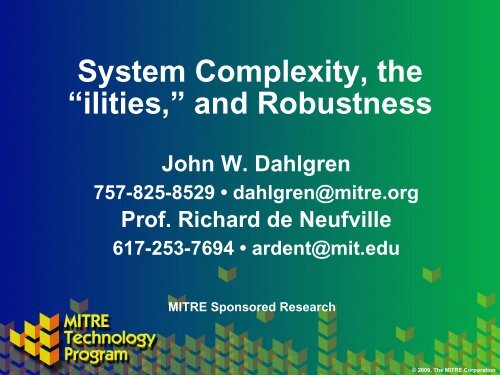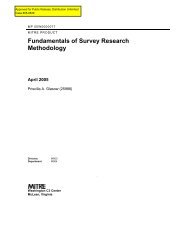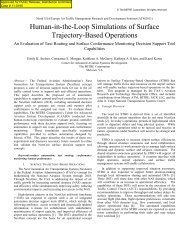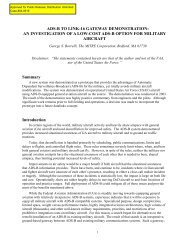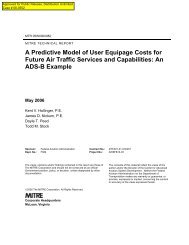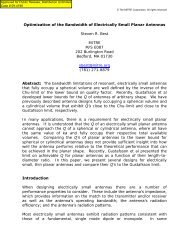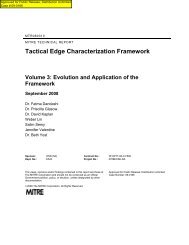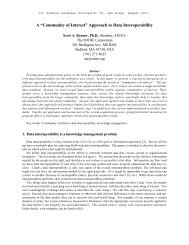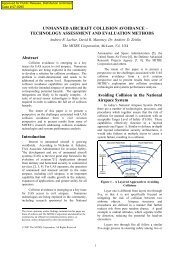Complex "ilities" MSR - Mitre
Complex "ilities" MSR - Mitre
Complex "ilities" MSR - Mitre
- TAGS
- complex
- ilities
- mitre
- www.mitre.org
Create successful ePaper yourself
Turn your PDF publications into a flip-book with our unique Google optimized e-Paper software.
System <strong>Complex</strong>ity, the<br />
“ilities,” and Robustness<br />
John W. Dahlgren<br />
757-825-8529 • dahlgren@mitre.org<br />
Prof. Richard de Neufville<br />
617-253-7694 • ardent@mit.edu<br />
MITRE Sponsored Research<br />
© 2006, The MITRE Corporation
Problem<br />
� Budgetary constraints will force systems to<br />
have a longer life cycle and greater adaptability<br />
to a variety of missions.<br />
� Systems engineers need to understand why<br />
some systems perform well in the “ilities”<br />
(flexibility, adaptability, upgradeability,<br />
reliability, scalability, and robustness) and<br />
others don’t so that they can incorporate that<br />
thought process into the design, development,<br />
and spiral development of new systems.<br />
� Program managers need a framework to price<br />
an option for incorporating one, some, or all of<br />
the ilities into their systems to meet user<br />
demand while minimizing life cycle costs.<br />
Discretionary<br />
Spending<br />
Future Years<br />
© 2006, The MITRE Corporation
Background<br />
� The DoD has adopted the JCIDS process for developing and<br />
acquiring systems in a more rapid and efficient manner.<br />
� Real Options offers a possible design and systems engineering<br />
paradigm for spiral development.<br />
� Professors Richard de Neufville and Oliver de Weck of MIT are<br />
working on pricing Real Options for systems.<br />
– Have studied phasing Iridium and phasing a parking garage as<br />
market demand becomes more certain<br />
� De Neufville’s work lays a good foundation for understanding<br />
options on individual attributes and groups of attributes (nested<br />
options).<br />
– Want options IN a project, not ON (go/no go) a project<br />
© 2006, The MITRE Corporation
Objective<br />
� Determine the initial design decisions and key<br />
attributes that support good performance in the<br />
ilities<br />
� Determine the cost of these attributes on historical<br />
systems: was it cheap or expensive as a percentage<br />
of overall system costs?<br />
� Determine how to price individual attributes<br />
(options) and groups of attributes (nested options)<br />
to possibly exercise in the future<br />
� In essence, help the PM make wise short-term and<br />
long-term design and investment decisions<br />
© 2006, The MITRE Corporation
Activities<br />
� Studying a variety of correlated and<br />
uncorrelated complex systems to determine if<br />
common design tenets relate across systems<br />
– Mobile Oil platforms for platforming<br />
opportunities<br />
– microUAVs for hot/cold spot analysis<br />
– VISA International for IT application<br />
– GPS for space system application<br />
© 2006, The MITRE Corporation
Highlight: Standardization Benefits<br />
� CAPEX reduction<br />
� OPEX reduction<br />
� Cycle time<br />
� NPV-based benefits, not interesting…<br />
� Uncertainty<br />
– Benefits depend on timing & capacity<br />
– Standardization � commitment � risk<br />
if not well planned<br />
– Standardization � flexibility � value<br />
if well planned<br />
– Major driver in preliminary design<br />
PV $<br />
Used with permission of MIT and Konstantinos Kaligeros<br />
Reduced CAPEX<br />
Improved Operability & Reduced OPEX<br />
Reduced Cycle Time<br />
Time<br />
© 2006, The MITRE Corporation
Highlight: Coupled DSM – Screening<br />
for “Hot” and “Cold” Spots<br />
STAKEHOLDERS<br />
OBJECTIVES<br />
ATTRIBUTES<br />
Static<br />
Analyses:<br />
SYSTEM BOUNDARY<br />
FUNCTIONAL DECOMPOSITION/ PROCESSES<br />
OBJECTS/DETAILS<br />
ACTIVITIES<br />
Working Definitions:<br />
AGENTS<br />
“Cold” Spots<br />
SYSTEM DRIVERS<br />
(Social, Political,<br />
Economic, System<br />
Constraints &<br />
Alterables)<br />
“Hot” Spots<br />
STAKEHOLDERS<br />
OBJECTIVES<br />
ATTRIBUTES<br />
Dynamic<br />
Analyses:<br />
SYSTEM BOUNDARY<br />
FUNCTIONAL DECOMPOSITION/ PROCESSES<br />
OBJECTS/DETAILS<br />
ACTIVITIES<br />
AGENTS<br />
SYSTEM DRIVERS<br />
(Social, Political,<br />
Economic, System<br />
Constraints &<br />
Alterables)<br />
- Nodes in an engineering system are “Hot” if future states are uncertain (change is likely) and<br />
changes have significant upside or downside consequences<br />
- Nodes are “Cold” if the are unlikely to change and likely changes have insignificant<br />
consequences on system<br />
t n<br />
t o<br />
t -n<br />
© 2006, The MITRE Corporation
Impact<br />
� Can influence the design of the vast majority of government<br />
projects<br />
� Supports near-term goals of a PM (1–3 year horizon) that must<br />
show impact while in charge while also supporting society’s<br />
long-term goals<br />
– PM can decrease initial and long-term costs<br />
– System meets user demand when it arises – good for PM<br />
and society<br />
– PM avoids excessive costs when user demand is<br />
inaccurate<br />
– Extends usable life of systems and mission applications<br />
� Program’s initial required investment and life cycle costs<br />
should decrease<br />
© 2006, The MITRE Corporation
Future Plans<br />
� Continue studying a variety of historical systems –<br />
possibly B-2, AOC, eBay, or Google<br />
� Apply to current systems – possibly airborne<br />
network, MILSATCOM system(s), and DoD IT system<br />
� Link together results of research on non-correlated<br />
systems to develop overarching principles related to<br />
design tenets that support good performance related<br />
to the ilities<br />
� Develop a framework to determine the value of a<br />
variety of options across a program or enterprise<br />
� Relate to other Real Options <strong>MSR</strong>s<br />
© 2006, The MITRE Corporation


